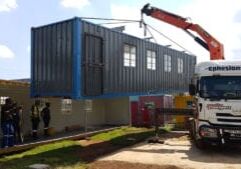Seizing the Modular Construction Opportunity
An executive summary from the CSA Group
Canada’s fast growing housing shortage has received significant attention recently. The need to build more facilities like hospitals and long-term care homes to prepare for an aging population is also looming. Could the potential of modular construction help accelerate the pace of building?
Currently, 4.3 million more homes are needed to help alleviate affordability and access issues, particularly for people with low incomes, students, and those who are unsheltered. Changing demographics mean that Canada will also require 199,000 new beds in long-term care facilities by 2035. But with an estimated 700,000 workers in the skilled trades expected to retire by 2028 and construction costs having risen by 51 per cent in recent years, new approaches are needed to meet this increasing demand.

The CSA Public Policy Centre’s new report, Seizing the Modular Construction Opportunity, highlights how innovative modular methods can help to bring various building forms—from single unit housing to complex high-rises—online more quickly. Owing to efficient manufacturing practices and controlled factory environments, modular can achieve completion rates that are 25% to 50% faster than conventional construction approaches.
Under the right circumstances, modular also has the potential to realize substantial cost-savings—upwards of 20%. And as Canada works towards greater circularity in the construction sector, modular’s standardized components allow for greater reuse and recycling which offer further opportunities to meet national sustainability goals. Though modular construction has seen strong growth in recent years—increasing from 2.14% of all construction starts in North America in 2018 to 6.0% in 2022—there are still several challenges hindering greater uptake in Canada.
The most fundamental barrier to modular construction is that it is poorly understood. From developers to tradespeople and key professionals like architects, engineers, and financiers, there is a general lack of awareness and technical know-how when it comes to designing, financing, and building modular projects.
Secondly, Authorities Having Jurisdiction (AHJs)—for example, the municipalities that oversee product safety, issue permits, and undertake inspections, or the provinces that approve changes to building codes—have limited experience with modular projects. This too often results in longer review and approval times, defeating the speed advantages offered by modular methods.
Thirdly, inconsistencies and gaps in building codes across jurisdictions make for a complex regulatory environment—particularly challenging when modular units are frequently manufactured in one province and transported to another for assembly. Building codes are also mostly silent on standards around transport, placement, and lifting of modules, which are important and unique aspects of factory-made buildings.
Finally, the way the public sector procures and finances construction projects is often at odds with how modular construction works. For example, large public projects like hospitals or schools usually come with highly prescribed architectural and engineering specifications that are more difficult for modular manufacturers to meet, given their set factory limitations. And while customization is possible to fit desired criteria, this can limit the potential cost savings that could otherwise have been achieved.
On the financing side, because as much as 80% of a modular project is completed in a factory, manufacturers require a much larger payment upfront to obtain needed materials and build modules concurrently. However, current practices among both private and public lenders rarely align with this approach, severely limiting the availability of financing options for modular projects.
If modular construction is to help Canada meet its unmet and growing infrastructure needs more quickly, cost effectively, and sustainably, governments at all levels must take action to enable an environment in which its potential can be maximized.

Download the complete version of the CSA Public Policy Centre’s new report, Seizing the Modular Construction Opportunity.
As a first step, provinces and territories can issue guidance materials and training to educate AHJs on modular methods and help clarify processes and responsibilities around certification, inspections, and approvals. This would allow projects to move forward more quickly and safely. Encouragingly, Ontario and British Columbia have already developed such materials.
Building code changes that enable modular construction are also needed. For example, the main standard used to certify modules off-site (CSA A277) is enforced to varying degrees across provinces in Canada, and its classification as an ‘administrative document’ within Canada’s National Building Code also creates uncertainty for local inspectors. While the most comprehensive solution would be consistent and harmonized recognition of CSA A277, an initial step would be to enhance education about the standard at the municipal level. Further, the recognition of CSA Z250—which addresses transport, lifting and placement of modules—in the National Building Code as well as codes at the provincial/territorial level could also support needed innovation in the building sector.
Next, governments at all levels should review their procurement practices to ensure bidding processes are more accessible to modular manufacturers and involve them earlier in the design and planning phases. More collaborative or integrated procurement approaches than the traditional ‘design-bid-build’ approach could help to secure greater cost-certainty and quality of construction, without compromising on the essential requirements of a given project.
Another critical action the federal and provincial governments could pursue is revision to the financing criteria for housing developments to better align with the reality of modular’s front-loaded project costs. The federal government in particular has set aside billions of dollars for affordable housing development through the National Housing Strategy. This could be made more accessible to modular builders who have unique advantages in rapidly producing buildings with efficient floor plans.
Finally, more research and evidence are needed to inform policymakers, regulators, and private developers of modular’s functions, merits, and limitations. Though evidence from other countries is demonstrating important benefits, decision-makers in the public and private realm are more likely to be persuaded by Canadian experience.
Modular construction presents real opportunities to help Canada meet key infrastructure demands—especially in the housing sector—more quickly, sustainably, and cost-effectively. However, this can only be achieved with broader awareness and understanding of modular methods, greater regulatory consistency and guidance, and more compatible procurement and financing practices—all underpinned by an expanding evidence base. All levels of government have important roles to play in enabling this future and ensuring the full potential of modular construction is seized.










